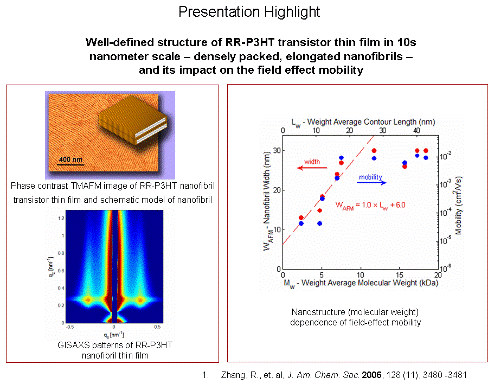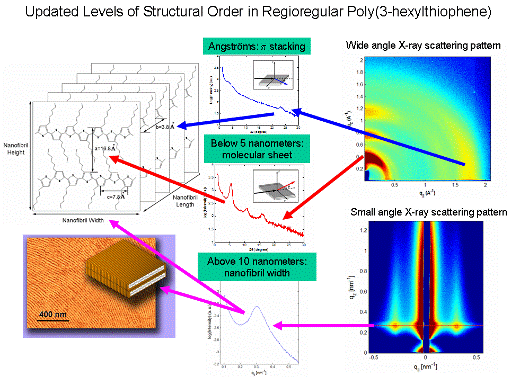











|
Carnegie Mellon University |

|
Poly(3-hexylthiophene) as a Conductive Material for Energy Transport and Storage Rui Zhang, Tomasz Young, Courtney Balliet, Emily Daniels |
|
The major focus and goal of this project is to develop new electrically active organic materials by utilizing self-assembly in highly-regioregular, narrowly-polydispered poly(3-alkylthiophene) homopolymers/block copolymers to explore the correlations of their nanostructures with their properties and the uses of these nanostructure materials in selected organic electronic devices. Regioregular polythiophenes belong to the family of (semi)conducting polymers which are the focus of intense studies, to a large extent driven by the prospect of developing cheap, easily processable electronics, but also by the promise of highly specialized applications such as (bio)chemical sensors and actuators. One of the outstanding problems in the field of (semi)conducting polymers is control of their nanostructure. We have recently demonstrated that formation of very well-defined nanostructure can be achieved by careful choice of processing conditions of regioregular poly(3-hethylthiophenes) (RR-P3HTs) with narrow polydispersities. A remarkable correlation of well-defined nanostructure with field effect mobility of thin film transistor has been unveiled in our recent studies. This remarkable correlation highly suggested that extended, conjugated states played a prominent role in the charge transport in semiconducting polymers. Creation of RR-P3HT block copolymers with a flexible block constitutes a versatile approach towards novel materials with tunable electrical and mechanical properties. We have recently established that changes in the structure of the flexible segment and/or variation of the molar composition of diblock copolymers can drive the formation of a range of nanofibrillar morphologies. The degree and regularity of nanofibrillar morphologies have profound impact on electrical properties of these diblock copolymer thin films. To explore the impact of RRP3HT nanostructures on its electrical properties, we are utilizing and developing proximal probe techniques allowing us to study the electrical properties at the nanoscale level. In combination with finite element modeling in Comsol Multiphysics, we are currently investigating electrostatics and dynamics of charge carrier’s injection into these well-defined nanostructures. |
|
Room 527, 4400 Fifth Avenue Mellon Institute Pittsburgh, PA 15213 Phone: 412-268-9175 |